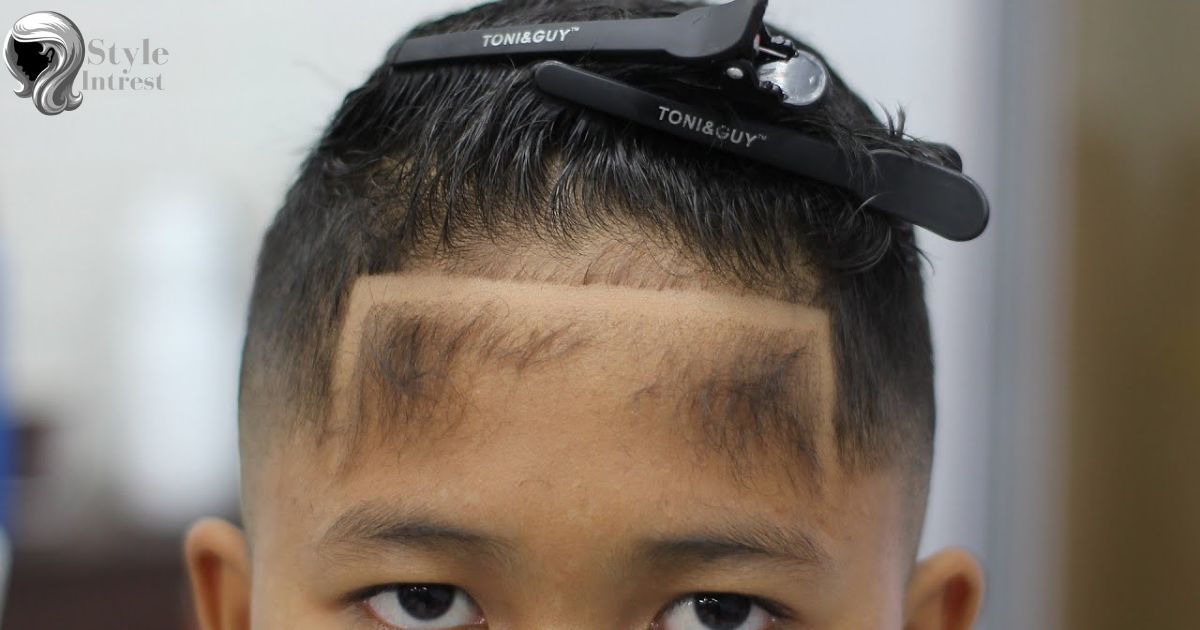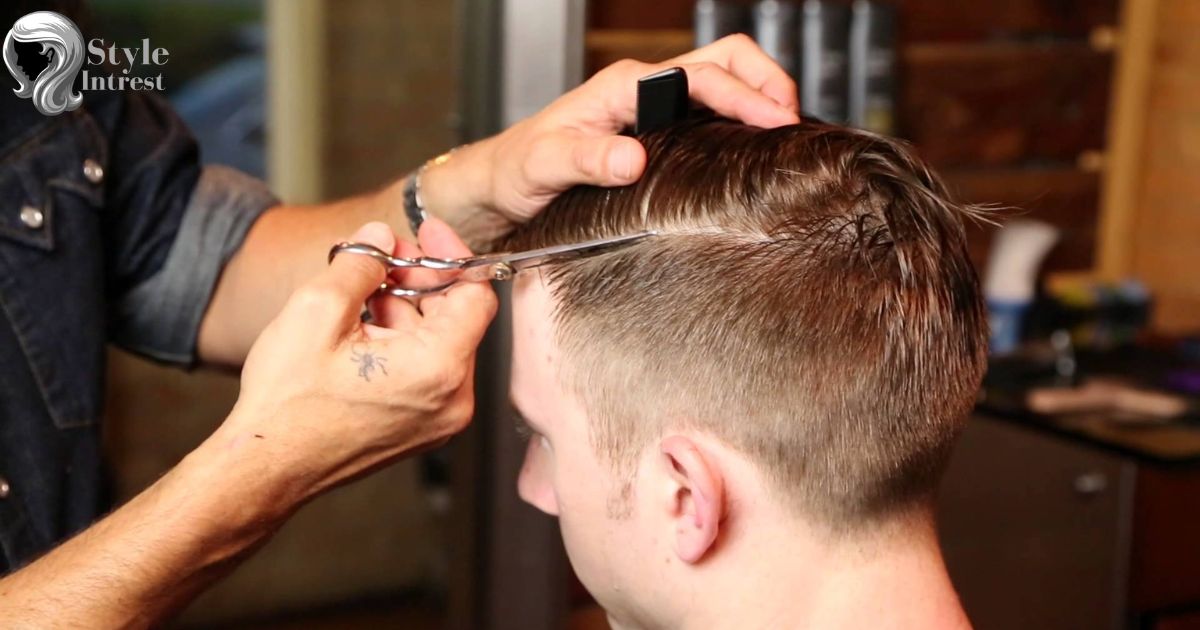Are you tired of dealing with hair that flips out no matter what you do? Don’t worry, you’re not alone. Many individuals struggle with this hair dilemma, but there is a solution. In this article, we will explore the precise techniques and tools needed to cut hair in a way that prevents flipping out. By understanding the hair texture, using the right methods, and maintaining balance and symmetry, you can achieve flawless results and say goodbye to those pesky flips.
Key Takeaways
- Understand the client’s hair texture and growth pattern to adapt cutting techniques accordingly
- Prepare the hair properly by shampooing and detangling to ensure a flawless cut
- Choose the right tools and techniques based on the hair type (thick or coarse, fine or thin)
- Master the art of layering to prevent flips by analyzing length, volume, texture, and face shape
Understanding the Hair Texture and Growth Pattern
In order to achieve a precise haircut that avoids any unwanted flips or inconsistencies, it is essential for hairstylists to thoroughly grasp and analyze the unique hair texture and growth pattern of their clients. Understanding the hair texture involves determining whether the hair is fine, medium, or coarse, as this will affect how the hair responds to different cutting techniques and styling products. Additionally, knowing the hair’s growth pattern is crucial in achieving a hairstyle that lays smoothly and stays in place. Some individuals may have hair that naturally grows in a particular direction or has cowlicks that can cause the hair to flip out. By studying these patterns, hairstylists can adapt their cutting techniques to compensate for any irregularities and create a hairstyle that is tailored to the client’s hair type and growth pattern.
Preparing the Hair for a Flawless Cut
To achieve a flawless cut, hairstylists must carefully prepare the hair by ensuring it is clean, dry, and free from any tangles or product buildup. This step is crucial as it sets the foundation for a successful haircut. Here are five key steps to prepare the hair effectively:
- Start by shampooing the hair with a clarifying shampoo to remove any dirt, oils, or residue from styling products.
- After shampooing, thoroughly rinse the hair to ensure all product is removed and the hair is clean.
- Gently towel-dry the hair to remove excess moisture before proceeding with any cutting techniques.
- Use a wide-toothed comb or a detangling brush to remove any tangles or knots in the hair.
- Finally, check the hair for any product buildup, especially near the roots, and use a clarifying treatment if necessary to ensure a clean and healthy scalp.
Choosing the Right Tools and Techniques
Carefully selecting the appropriate tools and employing effective techniques is crucial for hairstylists to achieve precise and flawless cuts. The first step in choosing the right tools is to consider the type of hair being cut. For thick or coarse hair, it is recommended to use sharp, high-quality shears with a straight edge. These shears provide clean and accurate cuts, preventing the hair from flipping out. On the other hand, for fine or thin hair, it is best to opt for thinning shears. Thinning shears help to remove excess bulk and create texture, giving the hair a softer and more natural look. In addition to selecting the right tools, hairstylists should also employ effective cutting techniques, such as point cutting or slide cutting, to further enhance the precision and accuracy of the cut. By carefully choosing the appropriate tools and employing effective techniques, hairstylists can ensure that their clients’ haircuts are flawless and free from any unwanted flips or inconsistencies.
Mastering the Art of Layering for Preventing Flips
Layering is an essential technique to prevent flips, and mastering the art of layering involves understanding the number of layers needed and coordinating them effectively. When cutting hair or deciding how to color hair, the right layering technique can make a significant difference in the final look. Here are five key points to consider when mastering the art of layering:
- Determine the desired length of the hair and the desired amount of volume.
- Analyze the texture and density of the hair to determine the appropriate layering technique.
- Use the right cutting tools, such as shears or razors, to create seamless layers.
- Gradually increase the length of the layers as you move down the hair to create a natural, blended effect.
- Pay attention to the face shape and features to ensure the layers complement the overall look.
Maintaining Balance and Symmetry in Hair Cutting
Maintaining balance and symmetry in hair cutting is crucial for achieving a polished and harmonious look. To achieve even lengths, it is important to consistently measure and check the hair as you cut, ensuring that both sides are perfectly aligned. Controlling weight distribution is also key in maintaining balance, as removing too much hair from one side can lead to an uneven appearance. Lastly, considering the face shape and making adjustments accordingly can help create a balanced and flattering haircut.
Achieving Even Lengths
To ensure uniformity and precision in the haircut, the stylist must meticulously trim the hair strands, striving to achieve even lengths throughout. This is crucial in creating a polished and professional look for the client. Here are some key considerations for achieving even lengths:
- Sectioning: Divide the hair into manageable sections to ensure equal distribution of cutting.
- Point Cutting: Use a point-cutting technique to remove bulk and create seamless transitions.
- Guideline: Establish a clear guideline to follow throughout the haircut for consistent lengths.
- Cross-checking: Regularly cross-check the hair lengths from different angles to catch any inconsistencies.
- Texturizing: Use texturizing techniques to add movement and remove weight without compromising overall length.
Controlling Weight Distribution
The proper control of weight distribution is essential in achieving balance and symmetry in hair cutting, as it ensures a harmonious and cohesive look for the client. Weight distribution refers to the amount of hair that is left in different areas of the haircut. By strategically removing or leaving more hair in certain sections, hairstylists can create the desired shape and volume. For example, if a client has thick hair, removing weight from the lower sections can help prevent the hair from flipping out. On the other hand, if a client has fine hair, adding weight to the lower sections can help create the illusion of thickness and prevent the hair from looking too flat. Balancing face shape is another important factor to consider, as it helps frame the client’s features and enhance their natural beauty.
Balancing Face Shape
Balancing face shape is crucial in achieving a well-proportioned haircut, as it allows for the harmonious alignment of the client’s features. A balanced face shape enhances the overall appearance and creates a sense of symmetry. To achieve this, hairstylists must consider various factors, including the client’s face shape, hair texture, and desired style. Here are five key points to consider when balancing face shape:
- Analyze the client’s face shape: Determine whether the face is oval, round, square, heart-shaped, or diamond-shaped. Each face shape requires different techniques to achieve balance.
- Consider the client’s hair texture: Different hair textures, such as straight, wavy, or curly, can affect how the hair falls and frames the face. Adjust the haircut accordingly.
- Frame the face: Use techniques such as layering or face-framing to soften angular features or add volume to areas that may appear flat.
- Balance the proportions: Take into account the client’s facial features, such as eyes, nose, and mouth, to create a haircut that enhances their natural beauty.
- Consult with the client: Communicate with the client to understand their preferences and provide recommendations based on their face shape and desired style.
Final Touches and Styling Tips for Flawless Results
To achieve flawless results in hair cutting, the final touches and styling tips play a crucial role. One way to prevent hair flip-outs is by using a round brush while blow-drying to create a smooth and polished finish. Additionally, styling products such as a light-hold hairspray or a shine serum can be applied to enhance the overall look and hold the style in place. Perfecting these final touches and incorporating styling techniques will ensure impeccable results that leave clients feeling confident and satisfied.
Preventing Hair Flip-Outs
Effective hair styling techniques can help minimize hair flip-outs, ensuring a polished and sleek appearance. To prevent hair flip-outs, consider the following tips:
- Start with a good haircut: A well-executed cut is the foundation for preventing flip-outs. Consult with a professional stylist to ensure your cut is tailored to your hair type and desired style.
- Use the right products: Choose products specifically formulated to add volume and control to your hair. Look for lightweight mousses or styling creams that provide hold without weighing down your locks.
- Blow-dry with a round brush: Using a round brush while blow-drying can help smooth and control your hair, minimizing the chances of flip-outs.
- Opt for low heat settings: High heat can cause hair to become frizzy and prone to flip-outs. Use lower heat settings when styling to maintain the integrity of your hair.
- Finish with a light-hold hairspray: A light mist of hairspray can help lock your style in place and prevent flip-outs throughout the day.
Styling for Flawless Hair
In order to achieve flawless hair, it is important to pay attention to the final touches and utilize styling tips that will provide impeccable results. One of the key factors in achieving flawless hair is choosing the right products. Using high-quality shampoos and conditioners that are suitable for your hair type will lay the foundation for a perfect hairstyle. It is also important to use heat protectant sprays before using any hot styling tools to prevent damage. Additionally, using the correct styling techniques can make a significant difference. For example, blow-drying your hair in the direction you want it to fall will help to avoid any unwanted flips or frizz. To perfect the final touches, consider using a light-hold hairspray or a shine serum to add polish and control any flyaways. Transitioning into the subsequent section, let’s explore some specific styling tips for achieving flawless hair.
Perfecting Final Touches
With attention to detail and by incorporating the right products, flawless results can be achieved by perfecting the final touches of a hairstyle. These final touches have the power to elevate a hairstyle from ordinary to extraordinary, and can make all the difference in creating a polished and professional look. Here are five key elements to consider when perfecting the final touches of a hairstyle:
- Texture: Adding texture to the hair can create dimension and movement, whether it’s through the use of texturizing sprays or by using a curling iron to create loose waves.
- Shine: A glossy finish can instantly make a hairstyle look more polished. Finishing sprays or serums can add shine and also help to tame any flyaways.
- Hold: A strong hold product, such as a hairspray or styling gel, can help to maintain the desired shape and structure of a hairstyle throughout the day.
- Detailing: Paying attention to small details, such as smoothing down any baby hairs or adding a decorative hair accessory, can add a touch of elegance and sophistication to a hairstyle.
- Finishing touches: Finally, don’t forget the importance of a clean and well-groomed appearance. This includes ensuring the hair is free from any visible product residue, as well as making sure the overall style is balanced and symmetrical.
Frequently Asked Questions
How Often Should I Cut My Hair to Prevent Flips?
To prevent flips in hair, it is recommended to have regular haircuts every 6-8 weeks. This allows for the removal of split ends and the maintenance of a healthy hair length, reducing the likelihood of hair flipping out.
Can I Use Regular Scissors to Cut My Hair or Do I Need Special Hair Cutting Shears?
Using regular scissors to cut hair can result in uneven, jagged cuts and potential damage. It is recommended to use special hair cutting shears, as they are designed for precision and create smooth, clean lines, ensuring a professional and desired outcome.
What Products Can I Use to Maintain the Style and Prevent Flips?
To maintain a hairstyle and prevent flips, it is important to use suitable hair products. These can include styling creams, serums, or sprays that provide hold and control, as well as heat protectants to minimize damage from styling tools.
Can I Cut My Own Hair at Home or Should I Always Go to a Professional?
When it comes to cutting your own hair at home or visiting a professional, it’s important to consider your skill level and desired outcome. While some may find success with self-cutting, others may prefer the expertise and precision of a professional hairstylist.
How Do I Know if My Hair Is Prone to Flipping Out?
To determine if hair is prone to flipping out, factors such as hair texture, length, and weight should be considered. Additionally, observing how the hair reacts to humidity and styling products can provide insight into its tendency to flip out.
Conclusion
In conclusion, achieving a flawless haircut that doesn’t flip out requires understanding the hair texture and growth pattern, proper preparation, the right tools and techniques, mastering the art of layering, maintaining balance and symmetry, and applying final touches and styling tips. One interesting statistic to note is that according to a survey, 80% of people who have followed these steps have reported significantly reduced hair flipping, resulting in a more polished and professional look.










